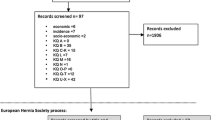Summary.
Repair of incisional hernias requires the extensive implantation of alloplastic materials. The extent of the scar tissue is markedly regulated by the amount and structure of the incorporated material and is responsible for the increased rate of local wound complications. Correspondingly, minimization of the alloplastic implants should be favorable. In a randomized, prospective clinical study, the early results were compared after implantation of either a minimized, low-weight (26.8 g/m2) mesh with a pore size of 5 mm or a common, heavy-weight (90.2 g/m2 polypropylene) mesh with a pore size of 0.8 mm. Indicators for clinical suitability were the rate and volume of seroma, subjective paraesthesia, physical capability, abdominal wall compliance, and the histologically analyzed tissue reaction of samples removed on the occasion of revision operations. As result, the optimized, low-weight mesh showed a remarkable decrease in the rate of seroma, patient complaints, less restriction of abdominal wall mobility, and improved abdominal wall compliance as verified by 3D stereography. These clinical findings corresponded to a pronounced decrease in inflammation and scar reaction, indicating improved incorporation of the alloplastic material. No other major complications except for one recurrence have been found.
Zusammenfassung.
Die Reparation von Narbenhernien machen eine großflächige präperitoneale Implantation alloplastischen Materials erforderlich. Die Menge und Struktur des eingebrachten Materials bestimmen aber das Ausmaß der induzierten unelastischen Narbenfläche und die Rate lokaler Wundkomplikationen. Dies macht eine Minimierung der alloplastischen Implantate wünschenswert. In einer prospektiven randomisierten Studie an 65 Patienten wurden die Frühergebnisse nach Implantation eines minimierten, leichtgewichtigen Netzes (26,8 g/m2 Polypropylen) mit 5 mm Maschengröße einerseits und einem schwergewichtigen, üblichen Netz (90,2 g/m2 Polypropylen) kleiner Porengröße (0,8 mm) andererseits verglichen. Als Parameter dienten die sonographische Seromrate und -menge, die subjektiven Mißempfindungen, die körperliche Aktivität, die Bauchwandmotorik mittels 3-D-Stereographie und die histologischen Veränderungen, soweit wegen akzidentieller Reoperation sich die Möglichkeit zur Probeentnahme ergab. Hierbei fand sich eine deutliche Reduktion der Serome, Mißempfindungen und Bewegungsstörungen sowie eine objektive Verbesserung der Bauchfunktionen mittels 3-D-Stereographie für das minimierte Polypropylen-Netz. Dies geht in der histologischen Auswertung mit einer geringeren Entzündungs- und Narbenreaktion, d. h. einer früheren Gewebsintegration des alloplastischen Materials, einher. Bis auf ein Rezidiv waren keine weiteren Komplikationen festzustellen.
Similar content being viewed by others
Author information
Authors and Affiliations
Rights and permissions
About this article
Cite this article
Schumpelick, V., Klosterhalfen, B., Müller, M. et al. Minimierte Polypropylen-Netze zur präperitonealen Netzplastik (PNP) der Narbenhernie Eine prospektive randomisierte klinische Studie. Chirurg 70, 422–430 (1999). https://doi.org/10.1007/s001040050666
Published:
Issue Date:
DOI: https://doi.org/10.1007/s001040050666




